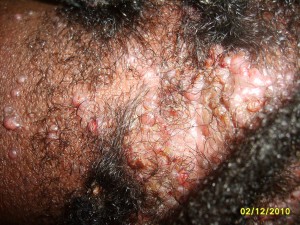What is the cause of “acne keloidalis?”
Shirin Bajaj, BA Roopal V. Kundu, MD
 Folliculitis papillaris or the commonly misnamed “acne keloid” (since it is not acne and does not result in keloids) is a chronic condition lasting many years occurring mostly in Black young men as itchy bumps on the back of the neck. These bumps may spread onto the scalp and even lead to patches of hair loss. It rarely affects other racial groups and has no relation to darkness of skin color. Women can rarely be affected. It often seems to first appear after a very close shaving of the neck during a haircut. Most affected persons show the presence of an abnormal scalp bacterium called staphylococcus aureus that is believed by some to contribute to the longevity of this problem. In the affected areas, local tissue damage from the curved, angled hair pushing through the skin can start the initial inflammation.
Folliculitis papillaris or the commonly misnamed “acne keloid” (since it is not acne and does not result in keloids) is a chronic condition lasting many years occurring mostly in Black young men as itchy bumps on the back of the neck. These bumps may spread onto the scalp and even lead to patches of hair loss. It rarely affects other racial groups and has no relation to darkness of skin color. Women can rarely be affected. It often seems to first appear after a very close shaving of the neck during a haircut. Most affected persons show the presence of an abnormal scalp bacterium called staphylococcus aureus that is believed by some to contribute to the longevity of this problem. In the affected areas, local tissue damage from the curved, angled hair pushing through the skin can start the initial inflammation.
How do I know if I have “acne keloidalis?”
Tiny similar-appearing red or flesh-colored bumps centered around hair pores on the lower back of the neck along the hairline are the first sign. Very rarely tiny pustules or “pus bumps” can reveal themselves. The bumps gradually enlarge but to different sizes and can range from pea-sized to thick broad bands of scar.
What are the best “acne keloidalis” treatments?
Unfortunately we do not know how to prevent this condition. Once it appears, if it is very itchy or bothersome, consultation with a dermatologist familiar with such conditions should be sought. Treatments for acne keloidalismay include ceasing greasy hair products, use of topical or even oral antibiotics, soothing topical cortisone preparations, injections into the bumps to flatten them or even cutting out large scar masses or using carbon dioxide laser to physically remove the bumps. The treatment process may require years of followup.
Download Spanish translation.
Descarga traducción en español.

Cutis Journal
Read published peer-reviewed articles written your by Skin of Color Society members

Did You Know
Skin of color patients comprise the majority in California, New Mexico and Texas…and soon will be the majority in Arizona, Nevada, Georgia, New York and Florida.
By 2042, more than 50% of the US population will have skin of color.




